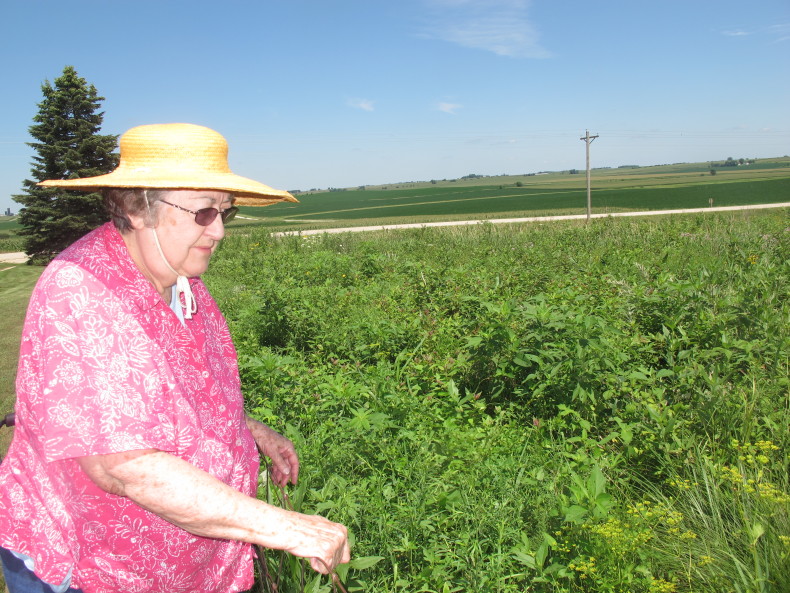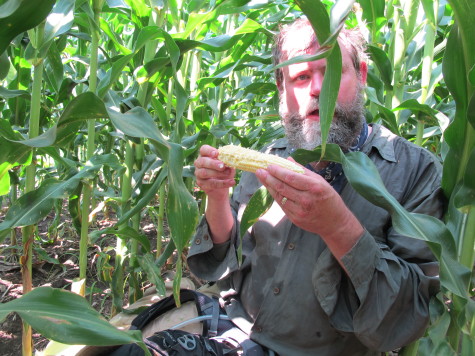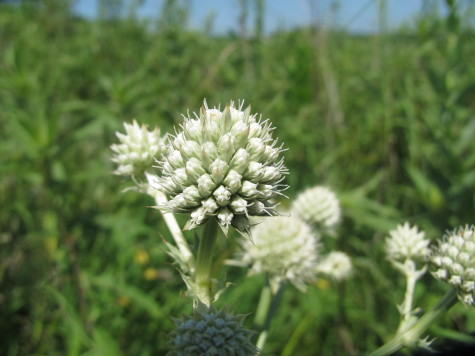 A summer not long ago I went for a grueling 3-day backpack through GMO cornfields in Iowa, camping among walls of waxy green leaves that sawed against each other in the breeze. I wanted to see what besides corn and soybeans lived out here. Not much, I found. Spiders and ants were few and only the smallest species survived. There were some mushrooms, but not many, and I happened into a whitetail deer one night. Otherwise, it was a catastrophic biological landscape, as if a bomb had gone off killing almost everything but a couple engineered species.
A summer not long ago I went for a grueling 3-day backpack through GMO cornfields in Iowa, camping among walls of waxy green leaves that sawed against each other in the breeze. I wanted to see what besides corn and soybeans lived out here. Not much, I found. Spiders and ants were few and only the smallest species survived. There were some mushrooms, but not many, and I happened into a whitetail deer one night. Otherwise, it was a catastrophic biological landscape, as if a bomb had gone off killing almost everything but a couple engineered species.
Thrashing out of the hot, dripping fields, my skin coated in sweat and grimy soil the consistency of shoe polish, I set off looking for signs of biologic hope in the area. I ended up at small patch of what is called virgin prairie, a plot of ground near the forgotten town of Butler Center where crops had never been planted. The town itself was gone, plowed under and turned into rows of corn, while this plot called the Clay Hills Preserve had been set aside. No plow had ever touched the ground.
Ruth Haan, a woman in her eighties, was one of the last on a board of volunteers overseeing the preserve. Locals warned me that Haan was losing her mental faculties. Her niece who drove her to the site to meet me on a blistering summer day said right in front of her that she was getting a little loopy.
“Oh, honey, I just need a little help now and then,” Haan said in her sundress, the fat of her arms hanging like handbags.
Haan pushed her wheeled walker across bumpy ground to reach the fence marking the refuge that she’d known her entire life. “Volunteers haven’t met for quite a while because most of us have died,” she said. “I sure hope someone will keep an eye on this after I’m gone; it’s the last piece around.”

On the other side of an old tangle-wire fence stood a waist-high briar of shrubs, grasses and flowers. It was not purely native by any stretch, but it was virgin, unplowed. If I hadn’t been pushing my way through monotonous parrot-feather green fields of corn for the last few days, this would have looked like a wild and forgotten lot, something you might mow down just to get the plants out of the way. Instead, to me it looked like a small paradise, horizons of corn and soybeans hemming it in on all sides.
Haan wore a yellowed straw sun hat and I could see her wearing that thing for years on her knees out here in the sun pulling up weeds. She stopped at the fence and said, “Smells good, doesn’t it?”
It didn’t smell like corn, I knew that.
With liver-spotted hands she pointed at a plume of fine grass and said, “When you find dropseed, you know it’s virgin; they didn’t plow it up. Wild parsnip, not native, shouldn’t be in there. Some of these shrubs and yucky stuff – that grass over there is invasive. It’s not supposed to be here, and, oh, nettles, nettles, that’s a shame. But, oh, look there, rattlesnake master.” She pointed at a plant bearing prickly greenish-white balls of flowers. Pioneers believed its roots could be used to cure rattlesnake bites.
“It’s a wonder it’s still here,” Haan said. “That makes me feel good to see that.”
I helped her along, holding her hand as she stepped from the walker and leaned against the fence, grabbing wire as she looked more closely at the rattlesnake master. “I wish it was prettier for you,” she said. “It’s pretty for me.”
Biologists I spoke with had little to say about such a small plot as the Clay Hills Preserve. They saw it as genetically indistinct, a drop in the bucket when looking at much larger habitat fragmentation, 90 percent of Iowa turned to cropland around it. This plot was hardly half an acre and Haan was no scientist, her eye more aesthetic than empirical. Still, I tried to understand what drove her to protect this place. In the big scheme, would it even matter? She thought my question was nonsense, as if it should be plain as day that a place like this matters.
I later spoke with the eminent biodiversity scientist Edward O. Wilson, mentioning Haan’s plot and other small preserved pieces of ground I encountered in Iowa. Wilson called much of what I saw artificial assemblages. When I told him I found an actual forest set aside as wildlife habitat in the middle of several corn fields, he asked, “Was it really a forest?”
In other words, were any of those trees part of an original ecosystem, or was its just a manufactured island of plant life, a mishmash anomaly that plays hardly a role in the bigger biological picture of the earth? I argued politely with Wilson saying, But there was diversity, there were birds!
Wilson told me about visiting a similar place in his homeland in Alabama where a heavily disturbed longleaf pine ecosystem had recently grown back in, many plants competing for sunlight. He said, “I thought it looked great. You know, it looked like a real, wild place.” But a botanist with him, one who worked in the area, told him that no, it wasn’t, saying that the floral diversity was actually quite low. Wilson said to the botanist, “Of course it will come back.” The botanist said no, he didn’t think so, not anytime soon.

Wilson said, “There is no such thing as rejuvenating a place by eliminating biodiversity, then letting biodiversity flow back in. We don’t have the millions of years that would take, it’s as simple as that.”
In the minds of many biologists, Haan’s plot is better than nothing but not by much. It is hardly more than a backyard garden. But slowly walking with Haan, I came to understand that it represents a fundamental human need. As much as we tend to fragment and destroy life around us through industrial action, there is also a drive to preserve diversity and prevent the destruction of every last thing. Without that drive, I fear the circumstance would be much worse. The site may have been genetically irrelevant, protected out of some sentimental urge, but it was a sign of action, a place where the longing for diversity could find at least a toehold. Instead of countless other possible hobbies, Haan was putting her life into one piece of virgin prairie.
With eyes sore from waves upon waves of corn, to me, it was like finding a remnant of Eden. When she said how good it smelled, I had to agree. It finally smelled like life.
Photos by Craig Childs (except for the one taken by the poor soul who joined me on the trek).
People used to understand this thing that E.O. Wilson said. No wonder he was so sad about it. When I was doing fieldwork among the horticultural Bwaba in Burkina Faso, their economy relied on a system of slash and burn, where they could afford to have only about 20% of their land in cultivation at any one time. The rest was all in various stages of secondary growth except for certain ancient climax forest, preserved as sacred groves. This produced a patterned mosaic of extremely high diversity, with abundant game and humming with insects and birds. Not so the vast fields of cotton and maize that are promoted by the development agencies like USAID not many miles away. And since I worked there, more and more of the traditional systems of subsistence farming (along with the people who farmed this way) are being displaced and replaced with more profitable eco-busting industrial agricultural as the green revolution relentlessly destroys older subsistence economies. The justification is always to “feed the world” – but I honestly never saw anyone starving in any of the traditional economies – only the refugees from development.
Great story. I think that drive to protect biodiversity is a need to have something wild and untamed around us. Something beyond our control, perhaps some vestige of our own wild nature. I think that’s why some people feed birds and other wildlife – not just because they are pretty (caged birds can be just as pretty), but because they are wild.
Can we feed 10 billion people without GMO foods? If not, then the choice between famine and biodiversity will be dictated by Malthusian economics. I have the luxury of living in the West and being able to afford to pay extra to buy sustainably grown food. Concomitantly, Western population growth is now generally negative. Much of the Earth’s population does not have the same expectation of food security, education, and healthcare as I do. Providing these three basic human rights to the world’s poor is likely the best long term solution to protect what little is left of the biodiversity on our pale blue dot.
Am I missing something? Was Iowa farmland a wealth of biodiversity in pre-GMO days? Seems I remember the fields have been largely corn/soy homogenous for quite a few years stretching beyond significant GMO use. The connection here seems weak at best.
The connection wasn’t meant to be strictly GMO,rather industrial agriculture that pushed out tall grass prairie beginning in the late 1800s. This is about severe habitat fragmentation. The GMO aspect is just the current realty.